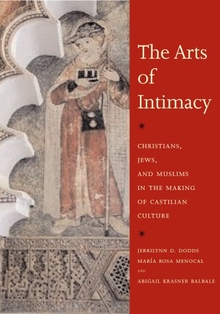The Arts of Intimacy
WARNING
You are viewing an older version of the Yalebooks website. Please visit out new website with more updated information and a better user experience: https://www.yalebooks.com
Christians, Jews, and Muslims in the Making of Castilian Culture
Jerrilynn D. Dodds, María Rosa Menocal, and Abigail Krasner Balbale
Named a Book of the Year by the Times Literary Supplement, this lavishly illustrated work explores the vibrant interaction among different and sometimes opposing cultures, and how their contacts with one another transformed them all. It chronicles the tumultuous history of Castile in the wake of the Christian capture of the Islamic city of Tulaytula, now Toledo, in the eleventh century and traces the development of Castilian culture as it was forged in the new intimacy of Christians with the Muslims and Jews they had overcome.
The authors paint a portrait of the culture through its arts, architecture, poetry and prose, uniquely combining literary and visual arts. Concentrating on the eleventh and twelfth centuries, the book reveals the extent to which Castilian identity is deeply rooted in the experience of confrontation, interaction, and at times union with Hebrew and Arabic cultures during the first centuries of its creation. Abundantly illustrated, the volume serves as a splendid souvenir of southern Spain; beautifully written, it illuminates a culture deeply enriched by others.
Jerrilynn D. Dodds is distinguished professor and senior faculty advisor to the provost for undergraduate education, City College of New York. She lives in New York City. María Rosa Menocal is director, Whitney Humanities Center, and Sterling Professor of the Humanities, Yale University. Her previous book, The Ornament of the World: How Muslims, Jews, and Christians Created a Culture of Tolerance in Medieval Spain, has been translated into seven languages. She lives in New York City. Abigail Krasner Balbale is a candidate for the Ph.D. in history and Middle Eastern studies at Harvard University, where she focuses on the cultural history of medieval Iberia. This is her first book.
Publication Date: November 3, 2009
10 b/w + 200 color illus.


